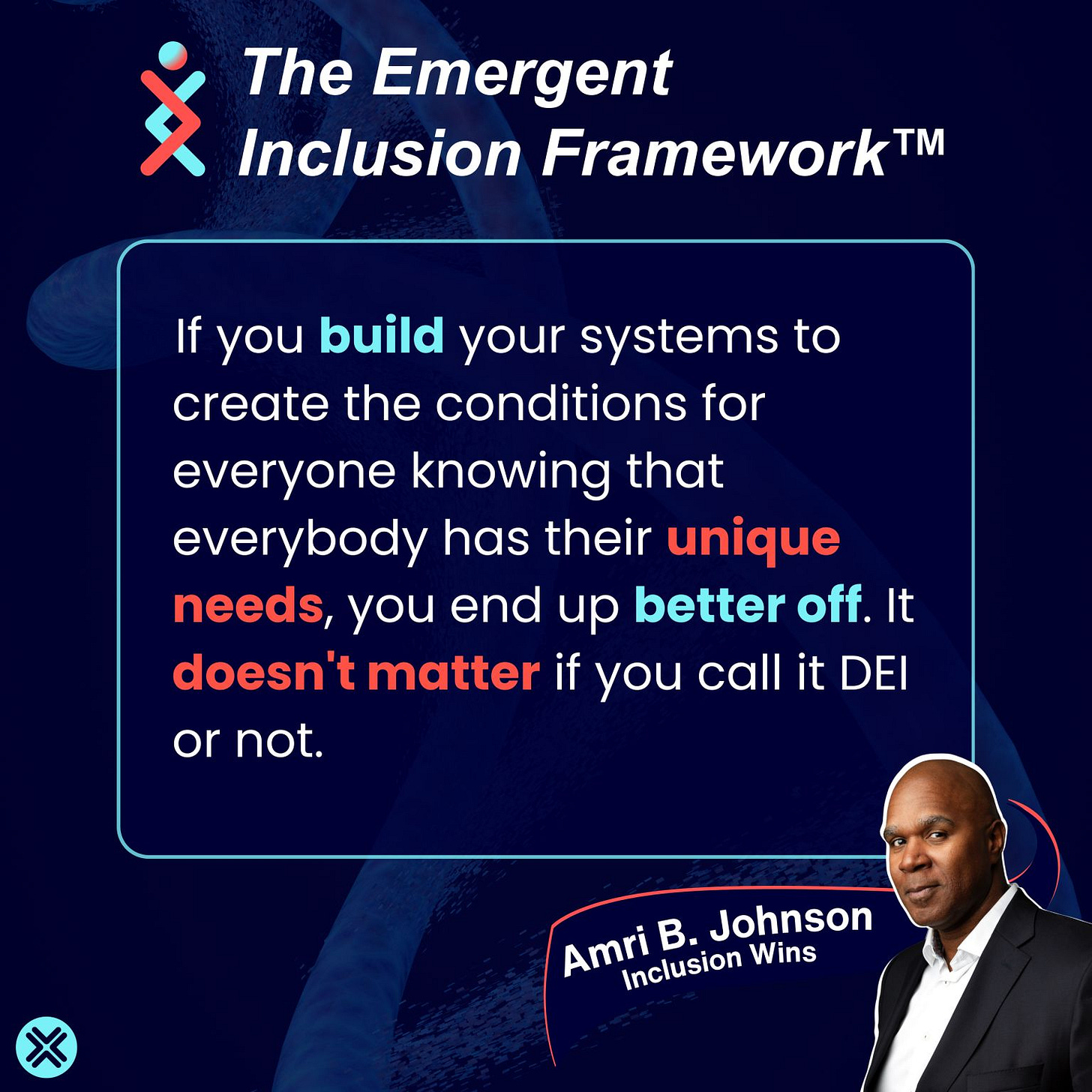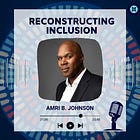Cognitive Diversity and the Real Work of Inclusion: Lessons from Professor Alex Edmans

Inclusion, diversity, and equity get plenty of airtime in organizational life (of course, a bit less so right now) but too often, the conversation begins and ends with what most often equate to checking boxes for representation of certain group demographics or chasing the optics of visible difference.
The deeper work, that which meaningfully changes the trajectory of a team or organization, isn’t in ticking diversity metrics. It’s in creating the conditions where every perspective can actually shape, challenge, and elevate collective thinking.
So, what would it look like to stop just inviting people into the room, and instead focus relentlessly on how that room works for everyone in it? What would it mean to value not just someone’s presence, but their thinking—how they see, process, and solve?
That’s the real invitation I see in Alex Edmans’ report, Cognitive Diversity in Asset Management.
Alex’s work has influenced me for quite a few years, starting with his book, Grow the Pie. What stands out about Alex is the way he makes a rigorous, data-driven case for the idea that doing societal good pays dividends, not from a utopian mindset, but backed by real empirical data and relentless honesty.
Edmans doesn’t make arguments from a wishful, idealistic place—he comes with receipts, with rigorous empirical evidence that cognitive diversity, when supported by real inclusion and psychological safety, moves the needle on decision-making and business outcomes in ways mere representation never will. But if you don’t have that foundation of psychological safety, if you’re not daily practicing real inclusion, all that difference gets muted or, worse, weaponized.
Below are my reflections—what I take away from Edmans’ work, what it means for the real, human-centered work of inclusion, and why, if we care about organizations that actually thrive in a world of constant change, we have to dig deeper than the superficial.
Why Cognitive Diversity? Why Now?
Alex has long been a voice cutting through the noise, urging us to move beyond easy narratives about identity or tired correlations, such as “diversity equals profit” (à la McKinsey research). Alongside thinkers like my colleague, Dr. Jonathan Ashong-Lamptey, he shows how those correlations, while well-intentioned, haven’t truly advanced the work. What’s needed isn’t more correlation, but more courage to create organizations where everyone can bring, test, and transform their ideas—no matter who they are.
This aligns with what I call creating the conditions for everyone to thrive and make their best contribution to the organization. That’s the cornerstone of my approach in the Emergent Inclusion Framework™. I discuss this throughout the framework—especially in the Relational Fitness Guide and the CQ Peak Principles components.
For me, inclusion isn’t just about what’s in the room (i.e., ascribed characteristics). It’s about who’s in the room (in all of our complexity), and more critically, how that room actually works for and to the benefit of every person showing up in it.
The who is us, in all our various dimensions and ways of seeing, being, and doing in organizational life. The how is the systems and structures, the behaviors, the practices that shape inclusion as embodied experience.
The Real Work: Edmans’ Empirical Case
In his report, Edmans frames cognitive diversity as the fuel for better decisions, creative problem-solving, and a real hedge against groupthink. But, and this is a critical distinction, those benefits don’t materialize just because more differences are present. Cognitive diversity only pays off when the team genuinely values those different perspectives through inclusion and the safety to voice, challenge, and revise ideas. Otherwise, those with divergent thinking—often from less-represented backgrounds, but not exclusively—remain unheard, and their performance suffers.
Truth be told, it’s not easier (and not always better) to add diversity (and stir); it’s way harder. Organizations need to intentionally develop skills, practices, and daily habits to surface the deep stuff: how people approach problems, how they see the world, what models and stories they hold.
This is one of the main insights that anchor my Emergent Inclusion Framework™—I’ve never believed diversity works alone. You can have a lot of “diversity,” but if the conditions aren’t right, people’s contributions are missed, regardless of how similar or different they seem to the majority. Again, my work focuses on what’s required to make sure every individual’s cognitive diversity actually matters.
Developing Effective Listening Skills
Beyond Optics: Inclusion as Daily Practice
I stole the idea from a couple of my favorite inclusion practitioners. I find myself saying it more and more: “Inclusion is much more about how the room works than who’s in the room.” The contrast and often-conflicting views between how diversity and inclusion are framed for most, and this sentiment, are where most of the tension in the media lies.
Every system, structure, and daily norm shapes whether someone’s perspective has weight. If you haven’t built the muscle for inclusion, more diversity just adds friction, not results. It’s possible to have a demographically or visually diverse group at the table and still end up in full groupthink.
Performative inclusion—what I sometimes call group identity optics, is surface-level and misses the point. I’ve written and spoken about this in many parts of the Emergent Inclusion Framework™, especially the Mettle Mindset Maker™, because I see mindset and the assumptions that drive behavior as central to genuine inclusion. For real inclusion to manifest, we need to shift beyond superficial diversity to relational and intellectual multidimensionality.
That’s true for folks who look different from the majority and for those who don’t. Without the right conditions in place, including psychological safety, any challenging or nonconforming perspective is likely to go unheard.
What Is Cognitive Diversity, Really?
Edmans isn’t talking about “diverse people” as if some are diverse and others aren’t—a notion I find ridiculous, since everyone is diverse in some way. He’s talking about real distinctions in how people think, including different life experiences, distinct problem-solving approaches, and ways of handling ambiguity and complexity. While his research is focused on asset management, he’s clear that this matters everywhere. And I can tell you, given the volatility, uncertainty, complexity, and ambiguity (VUCA) organizations face today, this is a universal challenge.
Too often, we let biases about who holds a certain dimension of difference or diversity shape how (or whether) we listen. These biases are barriers to unlocking the full value of cognitive diversity.
Why Does It Matter for Performance?
Cognitive diversity ups the game for decision-making—less groupthink, more surfacing of blind spots, more challenge to “the way it’s always been done.” Scott Page’s research (see The Difference) reinforces that these distinctions, handled well, expand a team’s capability, resilience, and output.
But for any of this to work, certain conditions must be in place:
High task interdependence: You’re not just a collection of individuals, but a team actually relying on each other. Interdependence is a key tenet of the Emergent Inclusion Framework™.
Complex, dynamic environment: Nothing is static—not people, not markets, not strategy. “Emergent” in my framework is about this constant evolution and adaptation.
Openness to influence: I’ve often defined inclusion as a willingness to be influenced by the so-called other. Edmans calls it members’ ability to openly share perspectives. I talk about this throughout my frameworks, and I know firsthand—this isn’t a transactional challenge. It’s a relational one.
Cognitive diversity can’t just exist on its own. It requires the right container, the right framing, and the right skills and capabilities to make it work.
The Downside: When Diversity Backfires
Edmans is rigorous in how he talks about diversity and he makes it clear, and this is often not said loud enough, diversity can actually hurt performance if inclusion and psychological safety are missing.
You might just get more silence, confusion, and division. If you aren’t ready to do the work of building deep inclusion capacity and strength. Demographic or even cognitive diversity alone usually just makes things messier, not better. You must intentionally design for the right kind of friction: productive, not destructive.
In the Emergent Inclusion Framework™, I emphasize developing “inclusion muscle” over time—practices and relational competencies that can move you from disagreement to dissent to generative dialogue. As I see it, if you don’t design for productive friction, cognitive diversity becomes a liability instead of a strength.
Psychological Safety: The Non-Negotiable
Cognitive diversity doesn’t thrive if people don’t feel safe to challenge, push, risk being wrong. Without that psychological safety, you get silence and stuck teams—even with all the differences in the world present. Safeguarding a culture of learning, candor, and robust disagreement is everything. As Dr. Edmans makes clear, when people feel safe to speak up and challenge norms, teams perform better. Without safety, groupthink prevails, and meaningful exchange is hindered.
This Isn’t Just Asset Management—It’s Universal
Edmans may be focused on asset management in his report, but if you’re breathing and running any organization facing new terrain, these lessons hold. Inclusion can’t just stay at the surface or be managed by policy—it has to be the undercurrent of how, every day, every person’s insights become part of the collective outcome. More than ever, as the world shifts and we’re bombarded with narratives about being replaced or made irrelevant, we need to double down on building the kind of thinking machines can’t replace—the human capacity to include, adapt, and create together.
Building a Better Future
The hard truth and the hopeful opportunity—none of this is achieved by decree, by checkbox, or by hiring for group demographic diversity. It’s about designing your organization for inclusion at every level—strategy, structure, rewards, culture, daily habits. That’s what I’ve set out to support in the Emergent Inclusion Framework™ and in all my work.
None of this is easy and it is increasingly more difficult and that’s why it needs doing. Let’s drop the easy talk. It’s time to build something real and lasting, powered by the deep, discerning, and dynamic potential of cognitive diversity.
If you’re willing to reconstruct inclusion from the inside out, to go deeper than optics and easy narratives, you’re in the right place.
This is the work and the way. Alex’s report and the current times indicate, more than ever, that now is the time for the deepening and reimagining inclusion alongside truly capturing the power of cognitive diversity.
Imagine where the field of diversity, equity, and inclusion would be if the contemporary focus for the “D” of DEI were on the cognitive vs. the demographic? What would the current discourse be?
Ready to transform inclusion from concept to action to being a cultural superpower?
When inclusion becomes "the way we do things around here," it transforms from initiative to being a key part of organizational identity.
Want to be part of this transformation? Our latest free virtual event on the Emergent Inclusion Framework is now available to watch on-demand. Whether you're a skeptic or champion, your voice matters in this conversation.
I hope this was helpful. . . Make it a great day! ✌🏿







